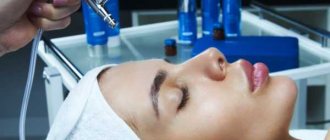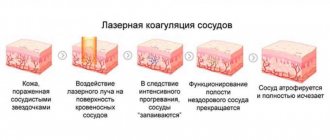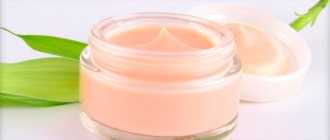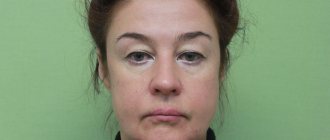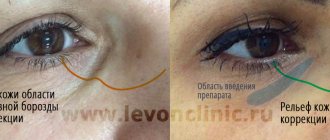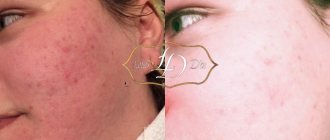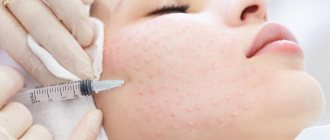Cosmetic surgery operates with a large number of terms that are incomprehensible to the common man. Rhytidectomy of the skin of the face and neck, what it is and why we need it, we’ll look into it in detail.
Every year the shape of our face and the condition of our skin changes. In youth, it looks more like a triangle with the apex at the chin. Over the years, the situation changes, and by a certain age you may notice how the top of the forehead becomes the top of the triangle, and the cheeks become the base. The face begins to gradually slide: the shape of the eyebrows changes, the corners of the eyes droop, the nasolabial folds become pronounced, the cheeks lose their elasticity, and a double chin appears.
How the stars of Soviet cinema and Hollywood age, see here...
The natural biological process of skin aging is individual; it is impossible to say at what specific age this occurs. Once you notice these changes, you can slow them down by maintaining a healthy lifestyle. But this does not always work out. Many modern procedures help restore youth to the skin of the face and neck, one of which is rhytidectomy.
What is skin rhytidectomy?
This is a simple operation for circular skin tightening. Offered to women after 38-40 years of age. With age, the epidermis loses elasticity and wrinkles appear. This is due to a decrease in collagen and elastin content in the skin.
Rhytidectomy is a surgical method to get rid of signs of aging on the face and neck. The procedure is complex. In addition to a circular lift, it includes liposuction - removal of fat deposits from the face and neck, getting rid of crow's feet, ptosis of the eyelids, eyebrows.
The operation lasts at least 2 hours. You need to prepare for it in advance by following several recommendations from your plastic surgeon. 8-6 hours before the start of the procedure you cannot:
- Smoking.
- Drink
- Eat.
Rhytidectomy is often performed on an outpatient basis. Hospitalization is required for complications or poor health after surgery. The patient, together with the doctor, chooses the type of anesthesia: local anesthesia or general.
According to women who have already undergone rhytidectomy, it is better to choose analgosedation for pain relief - a combination of sedatives and local analgesics.
About the procedure
A facelift (rhytidectomy)
is a plastic surgery to eliminate signs of age-related skin changes.
A facelift is one of the most popular plastic surgery procedures, allowing you to smooth out wrinkles and folds, even out skin texture, and restore freshness and youth to your face.
Today, many different techniques are used to combat skin changes caused by aging. However, only rhytidectomy often achieves the desired result when other tested methods have proven ineffective.
Of course, a surgical facelift is one of the most radical methods of skin rejuvenation, but the duration of its effect is measured not in months, but in years.
Experts identify
five criteria for age-related skin changes
:
- wrinkles,
- loss of skin elasticity,
- ptosis (sagging) skin,
- the appearance of pigment spots,
- loss of volume of soft tissues of the face.
Minimally invasive rejuvenation methods are quite capable of restoring tissue volume, eliminating wrinkles and pigmentation, but only rhytidectomy can effectively solve the problem of loss of elasticity of skin tissue and get rid of ptosis. The recommended age for it is 40-50 years
, when signs of aging have already appeared, but the skin has not yet lost its ability to regenerate. Accordingly, the indication for a facelift will be ptosis of the skin tissue, as well as the loss of elasticity and firmness and, of course, the woman’s desire to eliminate these signs of aging skin.
Read on topic:
Liposuction
Types of rhytidectomy
Operative lifting is classified into 3 types:
- Deep.
Indicated for women over 50-60 years of age. The surgeon grabs dense tissue - the superficial muscular-aponeurotic system (muscles, tendons).
This is the most effective method of tightening, but also more complex and dangerous for nerves and blood vessels. The recovery period lasts 4-6 weeks; extensive hematomas and swelling may occur. The sutures take longer to heal than with other types of lifts, and facial features may become distorted.
- Surface.
The doctor exfoliates the skin, tightens it, and cuts off the excess. The muscles are not affected during the tightening. Indicated for patients over 40 years of age.
- Combined.
Provides the opportunity to tighten several areas of the face. Internal and superficial tissues are excised.
Recovery after this type of oval correction comes with a lot of restrictions for the patient. You cannot stand up abruptly, lean forward, sleep on your stomach or side, or lift weights.
Lifting or plastic surgery - which is more economically profitable?
The cost of any procedure (for example, we mean a facelift with threads in Moscow) is determined by the complexity of the intervention, the price of consumables, the amount of work, the experience and qualifications of specialists.
How much does a thread lift cost today?
The price of a facelift with threads is based on the initial consultation with a doctor; carrying out the necessary examinations, taking tests; categories of clinic and doctor’s qualifications; the type and quantity of facial threads used (the cost of threads for implantation into facial tissue varies widely); volume of work - the area of the skin area that is being corrected. Specialists most often work with aptos threads (the most popular variety). The cost of a range of services is from 30 thousand rubles.
Cost of facial plastic surgery
The price of plastic surgery includes: initial consultation with a doctor; taking the necessary tests and conducting examinations; category of the clinic and degree of qualification of the surgeon; cost of consumables; volume of surgical intervention; volume of manipulation - the area of skin that is subject to correction; anesthesiologist's work and anesthesia costs; work of auxiliary medical personnel; the complexity of the intervention performed, taking into account all possible risks. The plastic method of age-related correction of changes is more complex, complex, and therefore the cost of facial plastic surgery is higher - from 150 thousand rubles.
Contraindications
There are several situations in which surgical lifting is contraindicated:
- Reduced blood clotting.
- Dermatitis.
- The presence of keloid scars and predisposition to their formation.
- General somatic ailments.
- Oncological diseases.
- Alcohol addiction.
- Diabetes.
- Hypertension.
- Infectious diseases.
- Exacerbation of chronic pathologies of internal organs.
- Pregnancy, lactation.
It is not worth deceiving the doctor and hiding aggravated diseases, anamnesis. Before surgery, patients are required to undergo a medical examination and undergo tests. Based on their results, a decision is made to satisfy the patient’s wishes or to refuse operations temporarily or forever.
Progress of the operation
The work of a plastic surgeon to tighten the skin on the face and neck takes place in three stages:
- Cutting the skin in the desired areas
If a facelift is performed, the doctor makes an incision in the skin from the temples along the ear down under the lobe and to the area behind the ear. To eliminate a double chin, an incision is made in the neck area.
- Removing excess skin.
The surgeon stretches the skin, holding it with special instruments. Removes extra centimeters with a scalpel. At the same time as lifting, excess fat on the cheeks, chin, and neck is removed.
- Stitching.
The stitching is done with absorbable threads. They do not leave very noticeable scars on the face. The incisions are stitched subcutaneously, located behind the ears, in the temporal region, under the chin.
After the procedure is completed, the woman is given a bandage made of elastic fabric. It fixes the facial and cervical area. This speeds up the tissue healing process.
Sutures are removed 2 weeks after surgery. The woman returns to her normal lifestyle after another 10 days, if there are no complications, severe swelling, or infections.
How is facial plastic surgery performed?
This is a full-fledged plastic surgery with mandatory preliminary examination and hospitalization. The early rehabilitation period is also carried out in a hospital setting. The intervention is carried out in a well-equipped operating room by a team of experienced, certified specialists.
The scientific name is circumferential rhytidectomy. General anesthesia is used. An incision is made, the tissue is separated and stretched. Excess skin is cut off, so plastic facelift is effective even with pronounced wrinkles. The tissues are securely fixed to the ligaments or periosteum, ensuring long-term preservation of the result.
Rehabilitation is long. The first weeks are the most difficult, then the process becomes easier. You will be able to go back to work only in a month. In addition, changes after plastic surgery on your face are irreversible. You'll have to get used to the new appearance. A scar remains on the skin. It is usually inconspicuous and located where it is not visible. However, much depends on the individual reactivity of the patient’s tissues.
Possible complications
Surgical lifting is considered a safe operation. Risks are possible, but their number is minimal. Complications of rhytidectomy include:
- Infection of blood and tissues.
- Injury to blood vessels and nerves.
- Allergies to anesthesia.
- Bleeding.
Swelling and bruising occur in 99% of women after removing the fixing bandage. It takes 1-2 weeks for wounds to heal and pain to subside. In general, the postoperative period is easy, negative reactions are short-term. The woman will be completely restored in 1-2 months: skin sensitivity will return, the scars will become invisible.
Indications for use of RF face lifting:
- loose skin;
- ptosis;
- presence of sagging skin;
- bags under the eyes;
- post-acne;
- facial wrinkles in the area of the nasolabial triangle, on the forehead;
Absolutely any part of the body is treated: face, arms, décolleté, buttocks, stomach, sides. Through thermolifting you can get rid of stretch marks (stretch marks). Thus, the use of RF lifting allows you to perform a facelift without major surgical intervention.
Skin care for the face and neck after a facelift
The effect of a circular lift lasts 7-10 years. To prevent it from being reduced to 5 or even 3, you need to follow the recommendations of surgeons for skin care.
During the acute rehabilitation period - 3-5 days after the tightening - patients should:
- Stop using any facial cosmetics.
- Refrain from hot food, taking a hot bath, or shower.
- Maintain physical rest as much as possible.
This is a difficult period for younger women, as they are accompanied by multiple prohibitions. You cannot massage your neck, chew vigorously, open your mouth wide, or laugh.
1-1.5 months after surgery, women are prohibited from:
- Visit baths and saunas.
- Exercise.
- Sunbathe.
- Wear tight clothes and shoes.
- Eat fatty foods.
- Dye your hair.
After rehabilitation, you need to establish proper nutrition and choose caring creams. The visible effect of the operation will become noticeable after a couple of months.
The circular lift technique requires high professionalism from the doctor. Choose a trusted clinic and an experienced surgeon. In this case, the risk of complications will approach zero, and obtaining the most effective, rejuvenated image will be guaranteed.
Features of the thread lifting procedure
A facelift with threads, also called a facelift, is a low-traumatic procedure. You do not need to be hospitalized for the procedure. Threads can be placed on an outpatient basis or in a one-day hospital setting - that’s why sometimes patients suggest calling the method non-surgical.
Key points of the intervention
A facelift is an operation, but in most cases general anesthesia is not necessary. To place the threads, local anesthesia is sufficient. There are no skin incisions, only punctures with needles. The skin is picked up by special hooks on threads and stretched in the desired direction. The threads remove part of the gravitational load and prevent the skin from sagging and stretching. Excess tissue is redistributed sideways, backwards or upwards. In this case, the excess tissue is sort of “gathered”.
Threads are attached to muscles, ligaments or periosteum. The doctor must have extensive experience and an excellent knowledge of anatomy in order to carry out the “thread face lifting” manipulation correctly, because it is necessary to act in areas of pronounced blood supply and innervation.
The rehabilitation period is short and passes easily. A few days after a facelift with threads, most people calmly go to work, without attracting the attention of others with their appearance. There are no scars left on the skin. The threads for the face are completely invisible and cannot be detected by touch. The performed circular facelift is reversible: if necessary, the threads can be removed without harm to the person.
